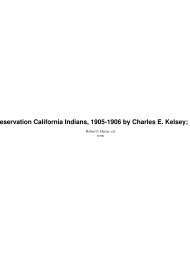Restoring a Bridge to the Past - Yosemite Online
Restoring a Bridge to the Past - Yosemite Online
Restoring a Bridge to the Past - Yosemite Online
You also want an ePaper? Increase the reach of your titles
YUMPU automatically turns print PDFs into web optimized ePapers that Google loves.
A T A L E O F T W O VA L L E Y S<br />
<strong>Yosemite</strong> National Park is home <strong>to</strong> two exceptional<br />
valleys: <strong>Yosemite</strong> and Hetch Hetchy (figure 1).<br />
<strong>Yosemite</strong> Valley is renowned for its spectacular<br />
waterfalls and bold granite icons such as Half Dome and<br />
El Capitan and is a magnet for visi<strong>to</strong>rs from around <strong>the</strong><br />
world. Hetch Hetchy Valley, although less well known<br />
and now <strong>the</strong> site of a reservoir for San Francisco’s water<br />
supply, is also quite remarkable. Indeed, John Muir,<br />
emphasizing <strong>the</strong> similarities between <strong>the</strong> two valleys,<br />
wrote. “Nature is not so poor as <strong>to</strong> possess only one of<br />
anything.” 1<br />
The first comparison of <strong>the</strong> two valleys was presented<br />
at a meeting of <strong>the</strong> California Academy of Natural<br />
Sciences in <strong>the</strong> fall of 1867 by Josiah Whitney, State<br />
Geologist and Direc<strong>to</strong>r of <strong>the</strong> Geological Survey of<br />
California. Hetch Hetchy was characterized as “almost an<br />
exact counterpart of <strong>the</strong> <strong>Yosemite</strong>,” and Whitney introduced<br />
a report by Charles Hoffmann, a member of his<br />
staff, who had explored Hetch Hetchy <strong>the</strong> previous summer.<br />
Hoffmann noted, “<strong>the</strong> scenery resembles very much<br />
that of <strong>the</strong> <strong>Yosemite</strong>, although <strong>the</strong> bluffs are not as high,<br />
nor do <strong>the</strong>y extend as far.”<br />
He described one waterfall (Tueeulala Falls) as having<br />
a sheer drop of 1,000 feet, and a second one (Wapama<br />
Falls) as a series of cascades dropping 1,700 feet.<br />
6 Y O S E M I T E A S S O C I A T I O N , F A L L 2 0 0 4<br />
BY N. KING HUBER<br />
Hoffmann remarked that a singular feature of this valley<br />
is <strong>the</strong> <strong>to</strong>tal absence of talus at <strong>the</strong> base of <strong>the</strong> bluffs,<br />
excepting at one place in front of <strong>the</strong> falls. Ano<strong>the</strong>r<br />
remarkable rock [Kolana Rock], corresponding with<br />
Ca<strong>the</strong>dral Rock in <strong>Yosemite</strong> Valley, stands on <strong>the</strong> south<br />
side of <strong>the</strong> valley; its height is 2,270 feet above <strong>the</strong> valley.<br />
These early observations 2 have relevance <strong>to</strong> <strong>the</strong> discussion<br />
of <strong>the</strong> two valleys presented here.<br />
The fundamental similarities that caught Muir’s eye<br />
were that both Hetch Hetchy and <strong>Yosemite</strong> are broad but<br />
steep-walled valleys incised in<strong>to</strong> <strong>the</strong> surrounding uplands,<br />
and that both have relatively flat floors traversed by meandering<br />
streams. Both valleys occupy similar positions on<br />
<strong>the</strong> western slope of <strong>the</strong> Sierra Nevada, with <strong>Yosemite</strong>’s<br />
floor at about 4,000-feet elevation and Hetch Hetchy’s<br />
slightly lower. Never<strong>the</strong>less, as noted by Hoffmann, Hetch<br />
Hetchy’s valley walls, while impressive, are not as high as<br />
<strong>Yosemite</strong>’s for <strong>the</strong> full length of <strong>the</strong> valley.<br />
Although Hetch Hetchy Valley is nearly 4,000 feet<br />
deep near its head, downstream near its lower end <strong>the</strong><br />
sheer cliff near Wapama Falls rises only about 1,600 feet<br />
from <strong>the</strong> valley floor (now submerged by <strong>the</strong> reservoir)<br />
<strong>to</strong> <strong>the</strong> upland plateau on <strong>the</strong> north. Kolana Rock, across<br />
<strong>the</strong> Tuolumne River on <strong>the</strong> south side of <strong>the</strong> valley, however,<br />
stands more than 2,000 feet above <strong>the</strong> valley floor,<br />
FIGURE 1. The “Two Valleys”<br />
of <strong>Yosemite</strong> National Park:<br />
<strong>Yosemite</strong> and Hetch Hetchy.<br />
Looking eastward <strong>to</strong>ward<br />
<strong>the</strong> Sierra crest, <strong>Yosemite</strong><br />
Valley is just right of center.<br />
It extends directly up from<br />
near base of figure, passing<br />
between Ca<strong>the</strong>dral Rocks on<br />
<strong>the</strong> right beyond Bridalveil<br />
Fall (shown against dark<br />
shadow), and bold El<br />
Capitan on <strong>the</strong> left, and on <strong>to</strong><br />
<strong>the</strong> valley head at <strong>the</strong> base of<br />
Half Dome. Tenaya Canyon<br />
can be seen entering <strong>Yosemite</strong><br />
Valley from <strong>the</strong> left below<br />
<strong>the</strong> face of Half Dome. Hetch<br />
Hetchy Valley extends from<br />
its reservoir (3rd one from<br />
lower-left corner) diagonally<br />
up <strong>to</strong> <strong>the</strong> right. Topographic<br />
features are diagrammatic<br />
and exaggerated in this stylized<br />
graphic by Heinrich<br />
Berann (NPS poster, 1988).




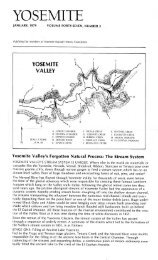
![(March 1982) [PDF] “We Are Pleased to Announce†- Yosemite Online](https://img.yumpu.com/51299748/1/190x242/march-1982-pdf-aeuroewe-are-pleased-to-announceaeur-yosemite-online.jpg?quality=85)
![[PDF] Old Horny, Yosemite's Unicorn Buck - Yosemite Online](https://img.yumpu.com/51269869/1/184x260/pdf-old-horny-yosemites-unicorn-buck-yosemite-online.jpg?quality=85)
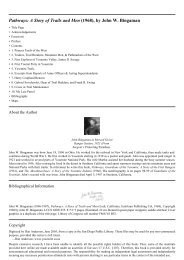
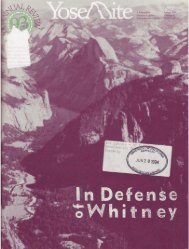
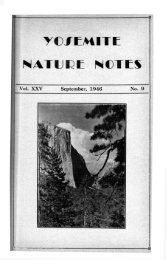
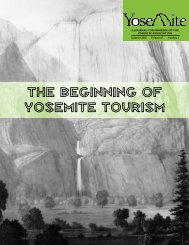
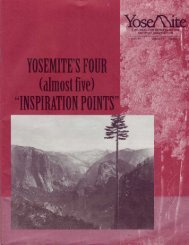
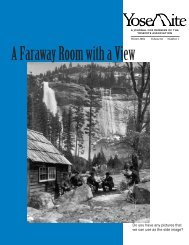
![1985 [PDF] - Yosemite](https://img.yumpu.com/48128837/1/184x260/1985-pdf-yosemite.jpg?quality=85)

